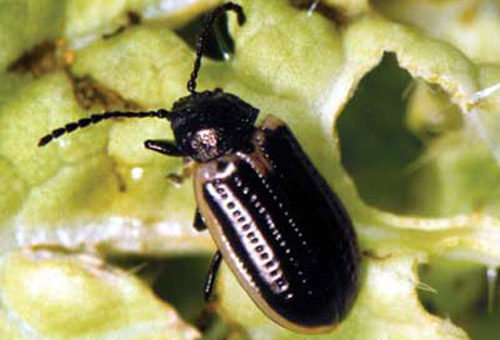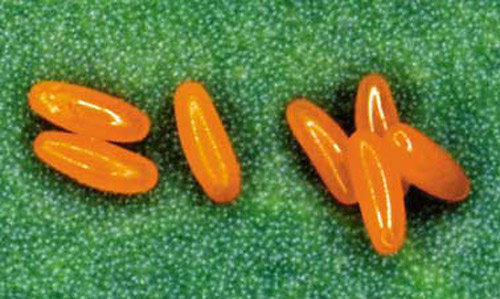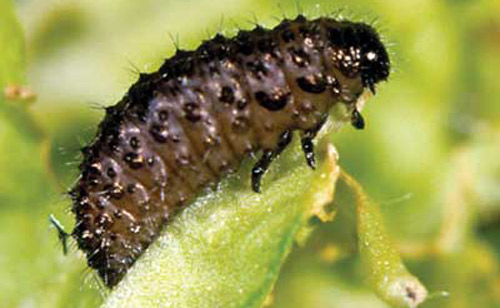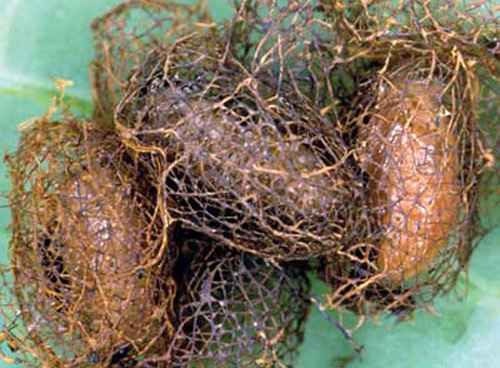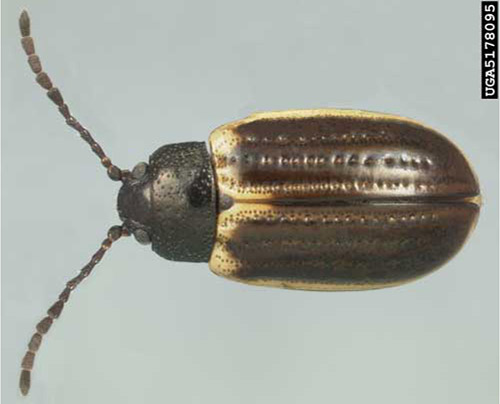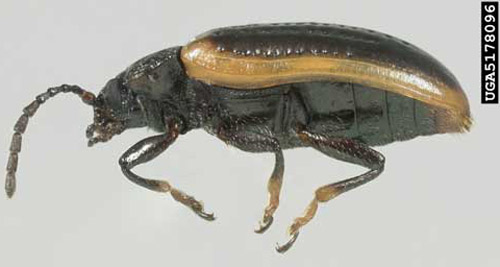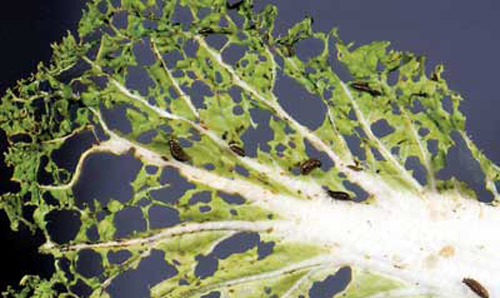common name: yellowmargined leaf beetle
scientific name: Microtheca ochroloma Stål (Insecta: Coleoptera: Chrysomelidae)
Introduction - Synonymy - Distribution - Description - Life Cycle - Hosts - Damage - Management - Selected References
Introduction (Back to Top)
The yellowmargined leaf beetle, Microtheca ochroloma Stål, is a pest of cruciferous crops. It was first recorded in the United States from Mobile, Alabama, in March 1947, feeding on turnip, cabbage, collard, mustard, and radish (Chamberlin and Tippin 1949). It can devastate high value crops, such as mizuna and mibuna (Japanese leafy vegetables), napa cabbage, turnip and watercress (Bowers 2003).
Figure 1. Adult yellowmargined leaf beetle, Microtheca ochroloma Stål. Photograph by J. Castner, University of Florida.
Bosq (1938) reported the destruction of 500 ha of turnips in Argentina. Chamberlin and Tippins (1949) reported Alabama infestations on garden plantings of cabbage, collard, mustard, turnip, and radish. They found no damage to commercial plantings, but the potential on these crops is apparent (Woodruff 1974).
Synonymy (Back to Top)
While some previous authors listed Microtheca punctigera Achard as a synonym of Microtheca ochroloma, Jolivet, who revised the genus Microtheca in 1950 and included 14 species, recognized both as distinct species on the basis of genitalic differences. No other synonyms are listed in the literature (Woodruff 1974). Arnett (2000) lists two species of Microtheca in the United States, but only Microtheca ochroloma is of economic importance.
Distribution (Back to Top)
Outside the United States, the yellowmargined leaf beetle is found in several South American countries (Argentina, Brazil, Chile, and Uruguay) where it is native (Woodruff 1974).
In the United States, Chamberlin and Tippins (1949) first reported it from Alabama in Mobile and Baldwin Counties. In 1956, it was reported for the first time in Tangipahoa Parish, Louisiana, on mustard greens. Eventually, its distribution was listed as 22 counties in four states (Woodruff 1974).
While Edwards (1949) listed the species from "Alabama and Florida," there does not seem to be a Florida record until 4 April 1972 when it was found in Tampa. It was then found on watercress (Nasturtium officinale R. Br.) at an aquatic nursery (Woodruff 1974). The first published report in Texas was from Harris County in 1977 when the beetle was discovered on collard greens, but there are specimens in the Texas A&M University insect collection from Galveston County dated 5 June 1975 (Drees 1997).
The beetle is now distributed along the Gulf Coast from Florida to Texas (Drees 1997), and in Georgia (Guillebeau 2001) and North Carolina (Kriz 1997).
Description (Back to Top)
Egg: The egg is bright orange, elongate, and laid singly or in small groups on plant stems, under fallen leaves, or on the soil surface (Bowers 2003). The egg stage lasts about four to five days (Capinera 2001).
Figure 2. Yellowmargined leaf beetle, Microtheca ochroloma Stål, eggs. Photograph by J. Castner, University of Florida.
Larva: The larva is grayish to yellow-brown, covered with a fine layer of hairs, and has a dark, sclerotized head capsule that is brown or black. The mature larva spins a peculiar blackish network around itself prior to pupation.
Figure 3. Yellowmargined leaf beetle, Microtheca ochroloma Stål, larva. Photograph by J. Castner, University of Florida.
Pupa: The pupal case is attached to the undersides of leaves, and their dark color stands out against the green foliage. The pupal stage lasts five to six days. New adults stay in the pupal case for about two days before emerging (Capinera 2001).
Figure 4. Yellowmargined leaf beetle, Microtheca ochroloma Stål, pupae in cocoons. Photograph by J. Castner, University of Florida.
Adult: The adult beetle is about 5 mm long and predominately dark brown, bronze or black. The margins of the elytra are marked with a margin of yellow or brown, a characteristic which gave this species its common name. Each elytron also has four rows of deep punctures. The third tarsal segment is bilobed (Woodruff 1974, Capinera 2001).
Figure 5. Dorsal view of an adult yellowmargined leaf beetle, Microtheca ochroloma Stål. Photograph by Natasha Wright, Florida Department of Agriculture and Consumer Services; www.forestryimages.org.
Figure 6. Lateral view of an adult yellowmargined leaf beetle, Microtheca ochroloma Stål. Photograph by Natasha Wright, Florida Department of Agriculture and Consumer Services; www.forestryimages.org.
Life Cycle (Back to Top)
Under favorable conditions, the beetle can complete its life cycle in less than one month. Adults can start copulating six days after they emerge from pupae, and females can lay eggs three to six days later. In Florida, adults remain active throughout the winter (Capinera 2001). More than one generation may occur per year during mild Gulf Coast winters (Capinera 2001). Ameen and Story (1997a) established the period from oviposition to adult emergence as 27 days, with eggs averaging 7.8 days, larvae averaging 10 days, prepupal averaging three days, and an average of 5.6 days for the pupa. Laboratory tests showed adult longevity ranges from 16 days on a diet of collard to 186 days on turnip (Ameen and Story 1997c).
Larvae are gregarious during their early instars, but become solitary later. Mature larvae spin loose net-like pupal cases on foliage. While some literature lists three instars, Ameen and Story (1997a) recorded four instars in laboratory tests, with 5% of larvae having a 5th instar.
Female adults fed on a diet of collard laid approximately 200 eggs versus about 300 more for females fed on turnip leaves. Results for females fed on other preferred hosts did not vary significantly from the turnip results but were fewer in number. Extremes were one female, fed on turnip, laying 1,497 eggs; another female, fed on collards, laying 10 eggs (Ameen and Story 1997c).
Ameen and Story (1997b) fed adults and larvae on several hosts for four generations. Results for most hosts showed a 70% multi-generational survivorship for four generations when the experiment was terminated after the fourth generation. Beetles fed on collards had a significantly reduced survivorship rate (0%) after four generations then beetles fed on other hosts.
Bosq (1938) reported the beetle as being most common during March in Argentina. A decline in beetle populations during mid-June to October may indicate aestivation, (Woodruff 1974, Capinera 2001, Bowers 2003). Bosq also found the pupal cases on or just below the soil surface (in a severe turnip infestation). The pupal cases found on watercress leaves may be an adaptation to an aquatic situation.
Hosts (Back to Top)
The normal hosts for this species are all in the plant family Brassicaceae. Vegetable crops that are damaged include broccoli, cabbage, cauliflower, collards, mustard, radish, turnip, and watercress (Wilkerson et al. 2005). Turnip is the most preferred host, followed by mustard, radish, collards and cabbage, in that order (Ameen and Story 1997b). However, as mentioned above, it is also a pest of mizuna (Brassica rapa, japonica group), mibuna (Brassica rapa, japonica group), napa cabbage (Brassica rapa, pekinensis group). These, like watercress and mustard, are high-value crops which are often grown organically (Bowers 2003).
In Florida, watercress is an important crop in a few areas. Most of the production is iced and shipped throughout the eastern United States and Canada. Yellowmargined leaf beetle is a particular problem on mustard and Chinese cabbage, especially for organic growers (Webb 2004).
Damage (Back to Top)
Most damage occurs in the spring when both the larvae and adults are found feeding on crucifers They feed on the foliage and leaf margins, making small holes, often defoliating the host. Larvae, especially early instars, work in groups to strip individual stems. Often this is a problem only in small or home gardens. Before the use of modern insecticides it was a commercial pest in South American fields (Capinera 2001).
Bowers (2003) lists three reasons why the yellowmargined leaf beetle is such a problem to growers in Florida. The beetle's host plants thrive in the cool months from October to April, and this period comprises the growing season for organic farmers in Florida. During these months, hard frosts or freezes are rare and the adult beetles can continue to feed and reproduce throughout the winter on an ample food supply. Finally, the yellowmargined leaf beetle is an introduced pest and has no known predators or parasites in the United States. Fortunately, this species seems to migrate at a slow rate, meaning it may not have the ability to rapidly expand its range under favorable conditions.
Figure 7. Yellowmargined leaf beetle, Microtheca ochroloma Stål, damage to leaf. Photograph by J. Castner, University of Florida.
Management (Back to Top)
The yellowmargined leaf beetle is not a problem for the average grower, as it usually is controlled by foliar insecticides used against other insect pests (Capinera 2001). However, organic growers encounter problems because they cannot use these materials, and some homeowners choose not to use insecticides (Bowers 2003).
For additional management information, see the Insect Management Guide for Crucifers.
In field studies of mizuna, populations of the beetle were higher on plants in the interior of the field than on the borders. In addition, intercropping did not appear to be a useful management tool against this pest on mizuna for organic farmers (Bowers 2003).
Selected References (Back to Top)
- Ameen AO, Story RN. 1997a. Biology of the yellowmargined leaf beetle (Coleoptera: Chrysomelidae) on crucifers. Journal of Entomological Science 32: 478-486.
- Ameen AO, Story RN. 1997b. Feeding preferences of larval and adult Microtheca ochroloma, (Coleoptera: Chrysomelidae) for crucifer foliage. Journal of Agricultural Entomology 14: 363-368.
- Ameen AO, Story RN. 1997c. Fecundity and longevity of the yellowmargined leaf beetle (Coleoptera: Chrysomelidae) on crucifers. Journal of Agricultural Entomology 14: 157-162.
- Anonymous. 1956. Yellow-margined leaf beetle (Microtheca ochroloma). Cooperative Economic Insect Report 6: 351-353.
- Anonymous. 1962. Yellow-margined leaf beetle (Microtheca ochroloma Stål). Cooperative Economic Insect Report 12: 109-110.
- Arnett Jr RH. 2000. American Insects: A Handbook of the Insects of America North of Mexico. CRC Press, Boca Raton, USA. 1003 pp.
- Bosq JM. 1938. Notas sobre insectos Argentinos perjudiciales a la agricultura. Revista Argentina de entomologia 1: 101-102. [Cited as 1940 by Jolivet, 1950.]
- Bowers K. 2003. Effects of within-field location of host plants and intercropping on the distribution of Microtheca ochroloma (Stål) in Mizuna. M.S. thesis. University of Florida. 63 pp.
- Capinera JL. 2001. Handbook of Vegetable Pests. Academic Press, San Diego, USA. 729pp.
- Chamberlin FS, Tippins HH. 1949. Microtheca ochroloma, an introduced pest of crucifers, found in Alabama. Journal of Economic Entomology 41: 979.
- Drees BM. (1997). Yellowmargined leaf beetle on leafy greens in Texas. (no longer available online).
- Edwards JG. 1949. Coleoptera or Beetles East of the Great Plains. Edwards Bros., Inc., Ann Arbor, USA. 181 pp.
- Jolivet, P. 1950. Contribution a l'etude des Microtheca Stål (Coleoptera, Chrysomelidae). Bulletin de l'Institut royal des sciences naturelles de Belgique 26: 1-27.
- Kriz RW (1997). Annual summary, plant disease and insect clinic -- insect data for 1996. North Carolina State University. (no longer available online)
- Rohwer KS, Guyton FE, Chamberlin FS. 1953. Status of the yellow-margined leaf beetle. Cooperative Economic Insect Report 3: 194-195.
- Stål C. 1865. Monographie des Chrysomelides de l'Amerique. Part III. Act. Soc. Roy. Sci. d'Upsal. (Ser. 3) 4: 177-365.
- Story R, Can F, Ameen AO, Murray MJ, Ring D. 1996. Control of yellowmargined leaf beetle on mustard with natural products extracts, 1995. p. 32. In Mostenbocker CE (ed.), Vegetable Research Report 1995, Louisiana Agricultural Experiment Station Mimeo Series, No. 116.
- Story R, Can F, Ameen AO, Murray MJ, Ring D. 1997. Control of yellowmargined leaf beetle on turnip, 1995. Arthropod Management Tests 22: 173.
- Woodruff RE. 1974. A South American leaf beetle pest of crucifers in Florida (Coleoptera: Chrysomelidae). FDACS-DPI Entomology Circular 148. 2 pp.
